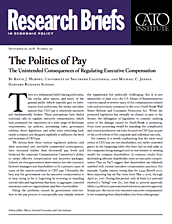We discuss how these various regulatory policies, and their associated and inevitable unintended consequences, have increased (rather than decreased) pay levels and hindered the corporate Compensation Committee’s ability to create effective compensation and incentive packages. Indeed, we view government intervention into the contracts between managers and shareholders to be a primary cause of many of the current problems in CEO pay. Ultimately, the best way the government can fix executive compensation is to stop trying to fix it, beginning by reversing or repealing myriad rules and regulations that have, in aggregate, imposed enormous costs on organizations and their shareholders. Fixing the problems caused by government intervention in the pay process is conceptually easy (simply remove the regulations) but politically challenging. But it is not impossible: in June 2017, the U.S. House of Representatives voted to repeal or rewrite many of the compensation-related rules and provisions contained in the 2010 Dodd-Frank Wall Street Reform and Consumer Protection Act. While the proposed legislation has virtually no chance to pass in the Senate, the willingness of legislators to consider undoing some of the damage caused by Dodd-Frank is promising. Even more promising would be repealing the complicated and counterproductive tax rules focused on CEO pay as part of the 2018 reform of the corporate and individual tax code.
For context, it is worth emphasizing that the most vocal critics of CEO pay are not shareholders, but rather uninvited guests to the bargaining table who have had no real stake in the companies being managed and no real interest in creating wealth for company shareholders. In contrast, results from nonbinding advisory shareholder votes on executive compensation (“Say on Pay”) suggest that shareholders are relatively satisfied with current executive compensation practices. For example, Equilar reports voting data for 2,444 Russell 3000 firms reporting Say on Pay votes from May 1, 2016, through April 30, 2017. During this period, only 38 firms (1.6 percent) received a “failing” vote (i.e., less than 50 percent approval), while 1,742 firms (71 percent) received over 90 percent approval. Simply put: the outcry over excessive executive compensation is not emanating from shareholders, but from other groups.
The apparent mismatch between the public criticism and shareholder acceptance of CEO pay is both instructive and important for our purposes. Although poorly performing firms with highly paid executives are especially vulnerable to failing advisory votes on CEO pay, the primary predictor of a failed vote (or shareholder dissatisfaction with CEO pay more generally) is poor performance and not the level of pay. In other words, shareholders are much more concerned about the alignment between pay and performance than the level of pay and are largely unconcerned when high-performing firms “share the wealth” with their top executives. In contrast, most attempts to regulate pay (through disclosure, taxes, legislation, etc.) have been singularly focused on reducing pay levels with little concern for underlying incentives. Thus, there is a mismatch between the objectives of the shareholders and those of the regulators, which in turn makes regulators try even harder to restrict CEO pay.
The reality is that CEO pay is already heavily regulated and that the regulations have been universally unblemished by success. Part of the problem is that regulation—even when well intended—focuses on relatively narrow aspects of compensation, allowing plenty of scope for companies to circumvent regulations by changing other, less-regulated components of pay. The analogy of the Dutch boy using his fingers to plug holes in a dike only to see new leaks emerge is apt. Each new hole requires a new regulation or set of regulations, introduced without repealing any existing regulations. The only certainty with pay regulation is that new leaks will emerge in unsuspected places, and that the consequences will be both unintended and costly.
A larger part of the problem is that the regulations are inherently political and driven by political agendas, and politicians seldom embrace value creation as their governing objective. While the pay controversies fueling calls for regulation have touched on legitimate issues concerning executive compensation, the most vocal critics of CEO pay (such as members of labor unions, disgruntled workers, and politicians) have been uninvited guests to the table who have had no real stake in the companies being managed and no real interest in creating wealth for company shareholders. Such critics mistakenly believe that providing CEOs with better incentives destroys rather than creates wealth for society at large. Moreover, a substantial force motivating such uninvited critics is one of the least attractive aspects of human beings: jealousy and envy. Although these aspects are seldom part of the explicit discussion and debate surrounding pay, they are important and impact how and why governments intervene in executive compensation.
NOTE
This research brief is based on Kevin J. Murphy and Michael C. Jensen, “The Politics of Pay: The Unintended Consequences of Regulating Executive Compensation,” Journal of Law, Finance, and Accounting (forthcoming), and USC Law Legal Studies Paper no. 18–8, April 2018, https://papers.ssrn.com/sol3/papers.cfm?abstract_id=3153147.

